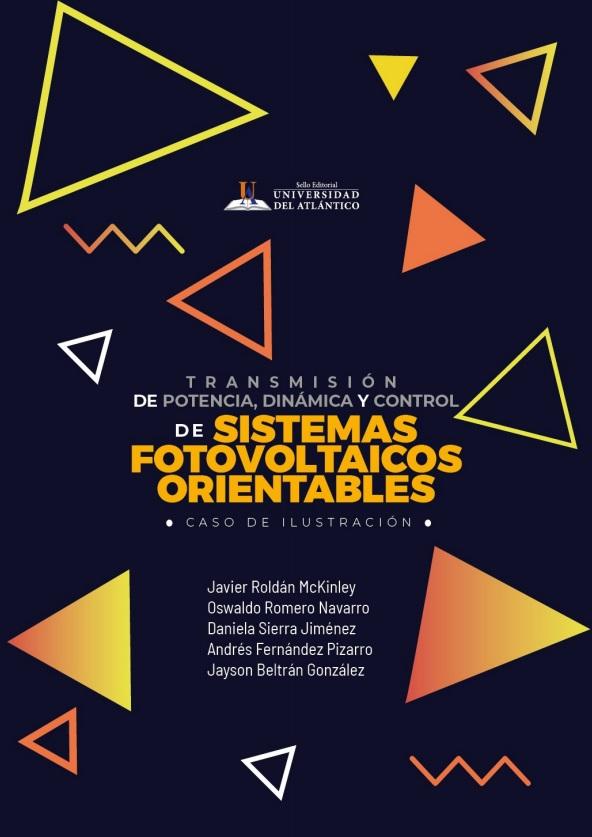Transmisión de potencia, dinámica y control de sistemas fotovoltaicos orientables • caso de ilustración •
Palabras clave:
sistema fotovoltaico orientable, potencia requerida, FEASinopsis
Esta sección presenta un estudio de alternativas comerciales para transmisión de potencia y movimiento en celdas fotovoltaicas. La potencia requerida se determinó considerando las cargas externas, internas e inerciales que afectan el conjunto seguidor en función de los ángulos de inclinación. Una vez seleccionados los actuadores y transmisión del sistema se procedió a evaluar la seguridad estructural mediante análisis de elemento finito con SolidWorks, teniendo en cuenta las cargas recomendadas por el Reglamento Colombiano de Construcción Sismo ResistenteNSR10. Se confrontaron la ganancia energética del sistema con la energía requerida para orientar la celda a lo largo del día para determinar los períodos mínimos de carga, obteniendo que se requiere cerca de 1,61 % de la ganancia energética del sistema para condiciones ambientales promedio.
Descargas
Citas
H. Mousazadeh, A. Keyhani, A. Javadi, H Mobli, K. Abrinia, y A. Sharifi, “A review of principle and sun-tracking methods for maximizing solar systems output”, ELSEVIER, Renewable and Sustainable Energy Reviews, vol. 13, no. 8, pp. 1800-1818, Jan 2009.
R. Eke, and A. Senturk, “Performance comparison of a double-axis sun tracking versus fixed PV system”, Solar Energy, vol. 86, no. 9, pp. 2665–2672, 2012.
M. Koussa, M. Haddadi, D. Saheb, A. Malek, and S. Hadji, “Sun tracker systems effects on flat plate photovoltaic PV systems performance for different sky states: A case of an arid and hot climate”, Energy Procedia, vol. 18, pp. 839–850, 2012.
R. Salcedo, y P. Monroy, “Prototipo de un panel solar orientable con seguidor”, Trabajo de grado de pregrado, Universidad del Atlántico, Barranquilla, Atlántico, Colombia, 2015.
C. Chin, A. Babu, and W. McBride, “Design, modeling and testing of a standalone single axis active solar tracker using MATLAB/Simulink”, ELSEVIER, Renewable Energy, vol. 36, pp. 3075-3090, 2011.
V. Poulek, and M. Libra, “A very simple solar tracker for space and terrestrial applications”, ELSEVIER, Solar Energy Materials & Solar Cell, vol. 60, pp. 99-103, 2000.
P. Bajpai, and S. Kumar, “Design, Development and Performance Test of an Automatic Two-Axis Solar Tracker System”, in India Conference (INDICON), 2011 Annual IEEE, pp. 1-6.
N. Tatu, and C. Alexandru, “Modeling and simulation of the tracking mechanism for a PV string”, in Automation Quality and Testing Robotics (AQTR), 2012 IEEE International Conference, Cluj-Napoca, pp. 428-433, May 2012.
N. Kumar, and N. Sharma, “Improve performance of PV system by PID controller”, Int. J. of Science, Engineering and Technology, vol. 4, no. 1, pp. 227-232, 2016.
L. Dwivedi, and R. Saket, “Improve efficiency of photovoltaic (PV) system based by PID controller”, Int. Research Journal of Engineering and Technology, vol. 4, no. 5, pp. 2273-2277, May 2017.
E. Kiyak, and G. Gol, “A comparison of fuzzy logic and PID controller for a single-axis solar tracking system”, Renewables: Wind, Water, and Solar, vol. 3, no. 7, 14 p, 2016.
Y. Safan, S. Shaaban, and A. El-Sebah, “Hybrid control of a solar tracking system using SUI-PID controller”, in Proc. of Sensors Networks Smart and Emerging Technologies (SENSET), Beirut-Lebanon, Sept. 12-14, 2017.
S. Hanwate, and Y. Hote, “Design of PID controller for sun tracker system using QRAWCP approach”, Int. J. of Computational Intelligence Systems, vol. 11, pp. 133-145, 2018.
C. Alexandru, “A novel open-loop tracking strategy for photovoltaic systems”, The Scientific World Journal, vol. 2013, p. 12, 2013.
R. Kelly y V. Santibáñez. Control de movimiento de robots manipuladores. Madrid: Pearson Educación, S.A., 2003, pp. 257-263.
MATWORKS, “Simulation and model-base design,” Agosto 2016. [Online]. Available: http://www.mathworks. com/products/simulink/
Feina SF9, “Solar Tracker Installation Manual”. Noviembre 2015 [Online]. Available: http://www.tracker.cat/solar-tracker-feina-sf09-en/?lang=en
Jurawatt, “Jurawatt 250 JWP”, Agosto 2016. [Online]. Available: http://bit.ly/2b4Jw3c
Dassault Systèmes SOLIDWORKS Corp., SOLIDWORKS [Software]. By: Dassault Systèmes S.A. (Euronext Paris: #13065, DSY.PA). Noviembre 2015. [Online]. Available: http://www.solidworks.com/
A. Barrientos, L. Peñin, C. Balaguer, y R. Aracil. Fundamentos de Robótica. 2da. ed. España: McGrawHill, 2007, pp. 119-143.
Denavit, and R. Hartenberg, “A Kinematic notation for lower-pair mechanisms based on matrices”, J. Applied Mechanics, vol. 22, pp. 215–221, 1955.
C. Crane, and J. Duffy, Kinematic analysis of robot manipulators, New York, NY, USA: Cambridge University Press,2008.
M. Spong, S. Hutchinson, and M. Vidyasagar, Robot dynamics and control, 2nd ed., New York, NY, USA: Wiley, 2004.
R. Jazar, Theory of applied Robotics, Springer: New York: Springer, 2007.
L. Tsai. Robot Analysis, The Mechanics of Serial and Parallel Manipulators. New York: John Wiley and Sons, Inc, 1999, pp. 395-403.
R. Kelly y V. Santibáñez. Control de movimiento de robots manipuladores. Madrid: Pearson Educación, S.A., 2003, pp. 257-263.
A. Fernández-Pizarro, y J. Beltrán-González, “Diseño de un controlador PID para gobernar el movimiento de paneles solares orientables”, Trabajo de pregrado, Dept. Ing. Mecánica, Universidad del Atlántico, Puerto Colombia, Colombia, 2017.
Sun Earth Tools, “Posición del Sol”. Jan 2017. [Online]. Available: http://www.sunearthtools.com/dp/tools/pos_ sun.php
K. Ogata. Ingeniería de control moderna. 5ta. ed. Madrid: Pearson Educación, S.A., 2010, pp. 570-571.
R. Budynas y J. Nisbett. Diseño en ingeniería mecánica de Shigley. 9na. ed. Ciudad de México: McGraw-Hill, 2012, pp. 688-689.
I. Dudás. The theory and practice of worm gear drives. London: Kogan Page, 2000, pp. 111.
Womack. Typical Power Transmission Efficiencies. May 2017. [Online]. Available: http://www.womackmachine.com/pdf/rb365/47th/section10/sec10pg504pumpmotortransmissionefficiencies.pdf
Phidgets. 3270_1 - 24V/14.2Kg-cm/192RPM 13:1 DC Gear Motor. Abril 2017. [Online]. Available: http://www.phidgets.com/products.php?category=24&product_id=3270_1
W. Bolton, Mecatrónica, Sistema de control electrónico en ingeniería mecánica y eléctrica. 2da. ed. México, Alfaomega Grupo Editor, 2001, pp. 172-174.
Texas Instruments, “LAUNCHXL-F28027 C2000 Piccolo LaunchPad Experimenter Kit,” SPRUHH2A datasheet, Jul. 2012 [Accesed Jan. 2014].
Texas Instruments, “DRV84x2 Dual Full-Bridge PWM Motor Driver,” SLES242G datasheet, Dec. 2009 [Accesed Dec. 2014].
Allegro Microsystems, “Fully Integrated, Hall Effect-Based Linear Current Sensor IC with 2.1 kVRMS Isolation and a Low-Resistance Current Conductor,” ACS712-DS datasheet, [Accesed Jun. 2017].
Phidgets. 3531 Optical Rotary Encoder HKT22. Abril 2017. [Online]. Available: http://www.phidgets.com/products. php?product_id=3531







